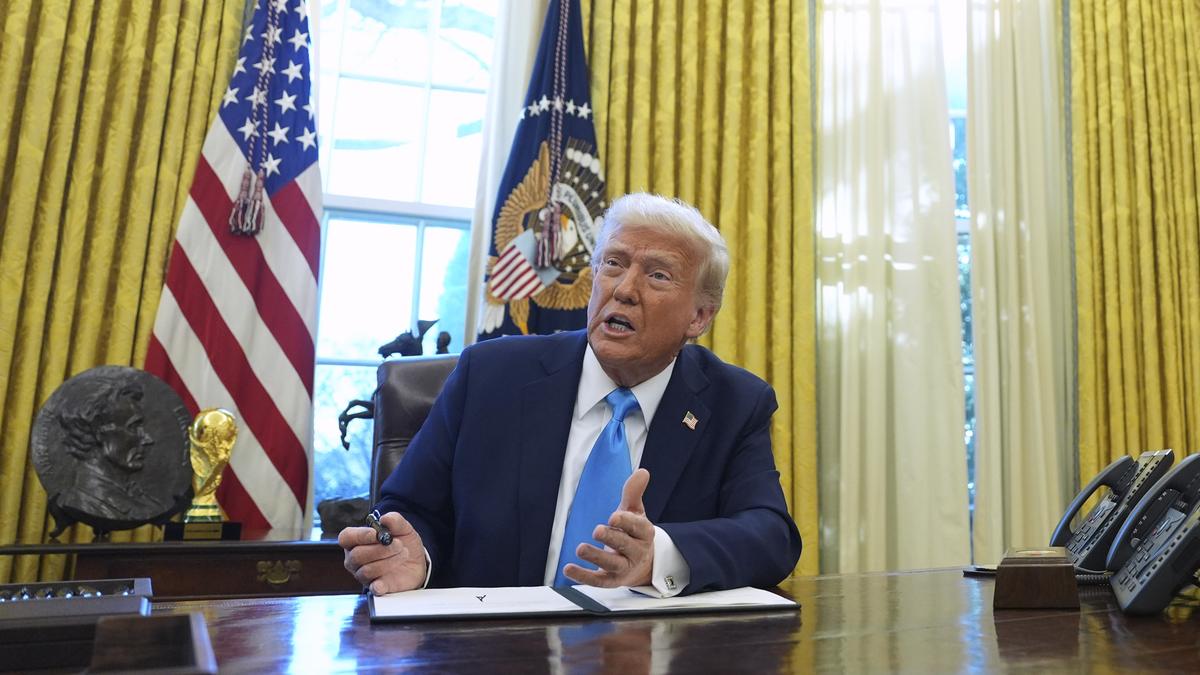U.S. President Donald Trump
| Photo Credit: AP
The story so far: U.S. President Donald Trump has sought to deliver, in the early days of his second term in office, on his most vociferous campaign promise — to slap a range of the U.S.’s trading partners with significant tariffs in a bid to tamp down on undocumented migrant and illicit drug inflows, while presumably incentivising companies to favour creating jobs on U.S. soil. His administration’s initial action in the space, to use executive orders to impose a 25% tariff on Canadian and Mexican goods and a 10% tax on energy products from Canada and a wide range of goods from China, roiled stock markets across the world, especially in Asia.
Editorial | Tariff turmoil: on Trump and punishing tariffs on trade
What followed the announcement?
As Beijing vowed to file a lawsuit with the World Trade Organization against the U.S. for “wrongful practice” and Ottawa and Mexico City announced plans for retaliatory tariffs, Mr. Trump appeared to back down from his position. Following discussions with Mexican President Claudia Sheinbaum and Canadian officials, Mr. Trump said the White House had agreed to “pause” the tariff action for a month in the wake of Mexico committing 10,000 National Guard troops to man its northern border and a longer-term bilateral deal in the works. Similarly, a 30-day pause on tariff action would be applied to Canada given its Prime Minister Justin Trudeau’s commitment to “work together” as his government sought to appoint “a fentanyl czar, list Mexican cartels as terrorist groups and launch a Canada-U.S. Joint Strike Force to combat organised crime, fentanyl and money laundering.”
While the tariffs on Chinese goods are in force, Mr. Trump temporarily exempted small-value packages imported from there after the U.S. postal service was plunged into chaos as it struggled to deal with new regulations.
What is the broader context for the tariffs?
Although in the traditional macroeconomic policy context, tariffs are imposed to rectify trade imbalances due to artificial price barriers, the justification given by the Trump White House for their tariff plan was that it would address the “national emergency” resulting from “the extraordinary threat posed by illegal aliens and drugs, including deadly fentanyl.”
This expansive reasoning for imposing tariffs across the board potentially risks blowback from other nations’ inevitable retaliatory tariffs. The resulting trade war could seriously dampen world trade at a precarious time for global economic growth prospects. The irony is that escalating tit-for-tat tariffs will likely exert strong upward pressure on the prices that U.S. consumers pay for imported products, and ignite a broader inflationary trend through higher input prices across industries.
The second cause for concern of the Trump administration’s tariff plan is that it tacitly endorses the weaponisation of tariffs as a countermeasure against unrelated inter-country disputes — in this case the inflow of unsanctioned migration and illegal drugs — rather than rely on traditional law enforcement activity to ensure less porous borders.
How have Mexico and Canada responded?
According to the White House, Mexican drug trafficking organisations have an “intolerable alliance with the government of Mexico”, and that the latter has “afforded safe havens for the cartels to engage in the manufacturing and transportation of dangerous narcotics, which collectively have led to the overdose deaths of hundreds of thousands of American victims.”
The Trump administration has also said that there is a “growing presence of Mexican cartels operating fentanyl and nitazene synthesis labs in Canada,” with a recent study recognising Canada’s “heightened domestic production of fentanyl, and its growing footprint within international narcotics distribution.” These facts, according to Mr. Trump’s administration, suggest that this is an alliance that endangers the national security of the U.S., requiring the eradication of the influence of these “dangerous cartels.”
Perhaps emboldened by his success in forcing Colombia to accept deportees from the U.S. flown to Bogota via military aircraft, Mr. Trump has used tariffs to bring Mexico and Canada to the negotiating table, even if his proposal violates the terms of the U.S.-Mexico-Canada free trade pact. Mexico has now already deployed most, if not all, of the promised troops to surveil and protect the U.S. border from unauthorised crossings. Reports also suggest that Mexican authorities have seized 20 million doses of fentanyl since Ms. Sheinbaum’s term began in October.
Mr. Trudeau initially responded with greater defiance, announcing retaliatory tariffs on $106 billions’ worth of imports from the U.S. However, despite reportedly being told that “Canada could avoid tariffs by becoming the 51st member of the U.S.”, he revived a border security package said to be worth $900 million, announced last year, and promised to appoint a “fentanyl czar”.
Where does China stand?
Mr. Trump’s 10% tariff levy on Chinese products is relatively modest compared to the 60% tariff rate that he had earlier threatened to hit Beijing with. Nevertheless, China was quick to announce a 15% counter-tariff to be levied upon imports of U.S. coal and liquefied natural gas, crude oil, agricultural machinery and certain cars — measures that are set to kick in on February 10.
In a more expansive counterattack, the Chinese government further opened an antitrust probe into Google, placed several top U.S. fashion and biotech companies on an “unreliable entities” list, and set limits on exports of critical minerals for high-tech products.
Nevertheless, analysts suggest that both sides have refrained from excessive or knee-jerk reactions, even though the 10% U.S. tariff on China adds to pre-existing levies imposed by Mr. Trump during his first term, and this leaves room for manoeuvre in negotiations that may follow when Mr. Trump meets Chinese President Xi Jinping in the near future.
However, with Mr. Trump promising stringent tariff action against the EU and other “reciprocal” tariffs against all trading partners of the U.S. in the days ahead in his mission to level the playing field, the risk of trade skirmishes derailing global growth prospects remains high.
Published – February 09, 2025 04:19 am IST
